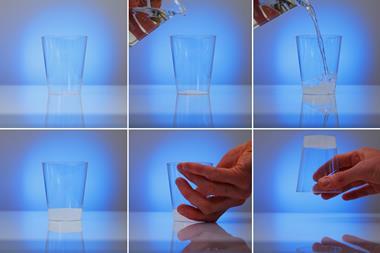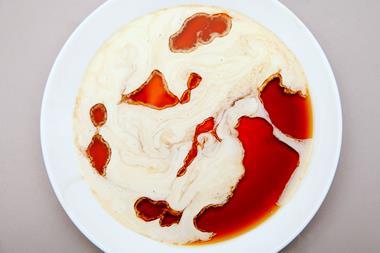Watch the video, download slides and technician notes from the Education in Chemistry website: rsc.li/EiC617ec
Many students under 16 struggle to distinguish between mixtures and compounds, or to appreciate the properties of a compound can be vastly different from that of a mixture. Some regard any diagram containing different symbols for atoms, whatever their location, as representations of mixtures.
This misunderstanding is disadvantageous to those who don’t continue with chemistry after age 16. They may leave school unprepared to dismiss claims about, for example, the hazards of ‘mercury’ in vaccines.
Therefore, when introducing the concept of a compound, memorable demonstrations that clearly show the formation of a compound are useful. This demonstration shows a compound and a mixture of its component elements with visibly different properties.
Kit
- Aluminium powder, 0.1 g (flammable)
- Iodine, 0.4 g (harmful in contact with skin and by inhalation)
- Weighing boats or small beakers
- Pestle and mortar
- Tin lid
- Washing up liquid
- Access to fume cupboard
Preparation
Wear eye protection and work in a fume cupboard. Weigh out the aluminium and iodine into separate vessels. Use a small beaker or weighing boat, not paper, to measure out the iodine. Spilled iodine will rapidly corrode top pan balances. Grind the iodine to a fine powder with a pestle and mortar.
Safety and disposal
Work in a fume cupboard away from naked flames. Wear eye protection. Avoid skin contact with iodine.
In the UK, do not exceed the suggested amounts unless the school has an explosives certificate issued by the police.
Wait until the mixture has cooled completely before soaking the tin lid or heat-resistant mat in water. (If hot, the mixture may produce hydrogen halide fumes on addition of water.)
Occasionally, the mixture fails to react (possibly because the aluminium is oxidised) or there is a very long period before it ignites. If it does not ignite, the mixture must be disposed of safely to prevent possible ignition after several hours. Add the solid to 1 M sodium thiosulfate solution, which can be further diluted before being poured down a foul-water drain.
In front of the class
Show the two powders separately so the class gets a sense for the properties of the elements. Then, carefully mix the powders together (do not grind the mixture). Place the mixture on a clean tin lid or heat-resistant mat. No reaction will happen until a drop of water (with a touch of washing-up liquid added to assist wetting) is added to the mixture of powder. After a short time, the reaction heat sublimes the iodine. Large quantities of purple iodine vapour will appear and the mixture will change to a pale yellow/cream colour.
Teaching goal
This simple demonstration works well at an early level as an introduction to the differences between the properties of a mixture of elements and the compound produced from them. Students can clearly see the change in colour. (Although the aluminium iodide compound ought to be white, impurities make it between white and brown.)
Students often struggle to distinguish between changes of state and chemical reactions. Instead, particularly around age 14, they hold the idea that whatever happens to a substance in a chemical reaction, each individual substance is conserved. The change of state in this demonstration, which is not a part of the reaction itself, provides an opportunity to model the difference in the arrangement of the particles before and after.
Probe what students think leads to the colour change. This diagram of the particles involved may help.
Probe what students think leads to the colour change. Diagrams of the particles involved can be downloaded from the Education in Chemistry website at rsc.li/EiC617ec.
There is plenty of value in repeating this demonstration for post-16 students too. The exothermic reaction is 2Al(s) + 3I2(s) → 2AlI3(s). The sublimed iodine visibly confirms the heat release associated with the reaction.
Like many compounds of aluminium, AlI3 can be a useful one to explore with post-16 students. International Baccalaureate students must be able to use a Van Arkel–Ketelaar bonding triangle and may find this compound of a metal and a non-metal more covalent than they previously predicted. AlI3 is a trigonal planar shape but the solid formed is the Al2I6 dimer. This gives opportunities to discuss Lewis acids and bases. The freshly-prepared product can be hydrolysed by water to form hydrogen iodide, which is why the reaction must be allowed to cool completely before attempting disposal.
Downloads
Clarifying compounds and mixtures technician notes
Word, Size 52.32 kbClarifying compounds and mixtures technician notes
PDF, Size 44.87 kbClarifying compounds and mixtures slides
PowerPoint, Size 3.79 mb


















No comments yet